
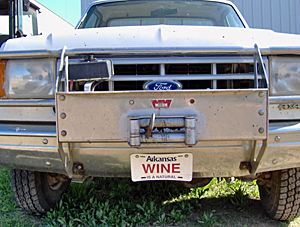
Ford Tough? - Welcome to Arkansas Wine Country Central in Altus AVA.
An Introduction to Arkansas Wine:
Diamonds in the Mountains of Altus
by
Tim Pingelton
May 30, 2007
Diamonds can only be found in a few places in the U.S. and one of those places is Arkansas. A major fault line cleaves the state from the north-east (near the site of devastating earthquakes almost 200 years ago) to the south-west (near Crater of Diamonds State Park). Seismic tumult further raised the Altus appellation to almost 3000 feet above sea level. Altus means “high” in Latin and this is the highest area in Arkansas.
The results of this unique geology are the beautiful vineyards, wineries, and wines in the Altus appellation. The five wineries in this 12,000-acre appellation have their singular distinctions, but they share a respect for the area’s geologic past, fruitful present, and promising future.
Driving to Altus on Highway 23 requires great attention to the road, but the lush vegetation, inviting streams, and incredible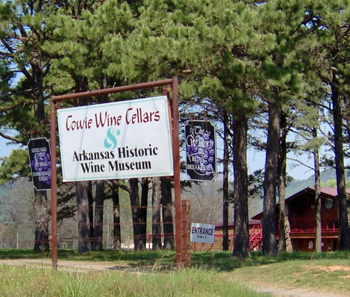
Cowie Wine Cellars and Vineyards sits at the foot of the Boston Mountains in Arkansas.mountain views make such caution difficult. The forest finally opens to the small town of Altus, home to five singular wineries. For the most part, the winery buildings are at the bottom of a foothill of the Boston Mountains called St. Mary’s Mountain, but the vineyards themselves are near the top of the mountain. From most Altus vineyards, Mount Magazine, the highest point in Arkansas, can be seen on the other side of the Arkansas River.
Muscadine, the predominate grape, is a hearty cultivar, thriving wildly in the humid summers, but a premature fall frost can kill it because of its horizontal rather than vertical (downward) root structure. This is the grape of The South. Typically, the nose of Muscadine is very close to that of Concord, and the wine is semi-sweet. Red, blush, and white Muscadine can be found in these parts, but all Altus wineries also make wine from vinifera such as Cabernet Sauvignon and Chardonnay, too. These less hardy cultivars are able to thrive on the mountain-top vineyards due to a weather system unique to the area.
A visit to the Post Winery makes evident the interconnections of family and winemaking. Jacob Post’s original grape press, a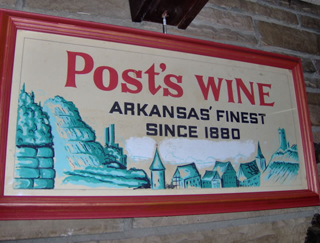
Post Familie Vineyards and Winery likes to show off its history.humble old oak contraption about the size of a wine barrel, is not far from the current press, a stainless steel beast about the size of a van.
A “toast with Post” is advised, but only after a thorough tasting to discover how careful vineyard practices and smart winemaking can reveal the true product of terroir and fruit. The Post Familie 2004 Munson has a slight herbaceous quality and tartness reminiscent of Chambourcin, but its smooth tannins allow big cherry tones to step to the fore. The Posts have found this hearty hybrid especially suited to their growing conditions, and very little human intervention is needed to let the berry’s natural expression reveal itself in the finished wine.
Winding up the road from Post Familie is “U.S. Bonded Winery #8, Wiederkehr Wine Cellars. They, like Post, have a surprisingly long and diverse listing of wines produced. Wiederkehr embraces the Swiss upbringing of Johann Andreas Wiederkehr, who settled in Altus in 1880. The property resembles a small Swiss village, and the hospitality shown by the personnel (clad in traditional Swiss attire) comfortably defies place and time.
The estate wines here are demonstrations of what can be wrought from “simple” grapes such as Niagra, Vidal Blanc, and Muscadine. They are true to varietal form, and their many blended wines strive to diminish the faults in these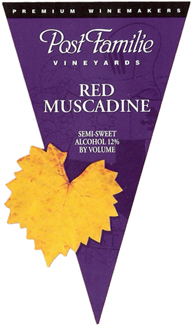 humble grapes and to expose their opportunities. Wiederkehr’s “Arkansas Natural Wine,” a white blend featuring Muscat and Vidal Blanc, is an excellent summer sipper—Muscat nose, Vidal reminiscent of true Chablis, and a crisp, refreshing finish.
humble grapes and to expose their opportunities. Wiederkehr’s “Arkansas Natural Wine,” a white blend featuring Muscat and Vidal Blanc, is an excellent summer sipper—Muscat nose, Vidal reminiscent of true Chablis, and a crisp, refreshing finish.
Farther north on Highway 186 is Chateau Aux Arc Vineyards and Winery. The name is the etymological root of what is now spelled and pronounced “Ozark.” The vineyard here was planted in 1998 by Audrey House, certainly one of the youngest people to operate a winery. She first planted German cultivars rare to the United States and has since planted more common vinifera to total almost 40 acres planted. Audrey takes to heart the adage that good wine begins in the vineyard: harvesting is done by hand, and she uses collected rainwater for irrigation.
The attractive tasting room at Chateau Aux Arc is situated amid the vineyard, so visitors can see the fruit before it becomes wine. Audrey has planted ten acres of Chardonnay. The 2003 Chardonnay is yet another example of the flexibility of that grape. Here, a small portion of the batch was stored in oak barrels to deepen peach and vanilla tones. 2005 saw a smaller Chardonnay harvest (there was no Chardonnay harvest in 2004 at Chateau Aux Arc), but the 2005 promises to deftly combine brightness and complexity as did the 2003.
Back down the mountain past Post Familie, is a big field of contented grazing cattle. Cutting into the field is a long drive that leads to Mount Bethel Winery. Originally named the Mrs. Joseph Post Winery, Mount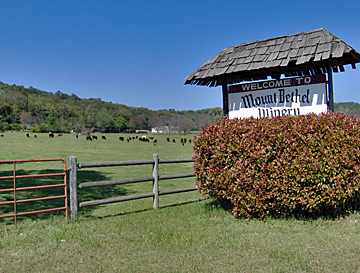
Mount Bethel Winery is located among the mountain trees beyond the cow pasture.Bethel Winery produces about 12,000 gallons of wine annually from estate-grown grapes. They also have acreage devoted to fruit for their non-grape wines.
Most of their wines spend some time in large redwood casks before being racked to oak barrels. Their biggest redwood cask is named “Big Daddy.” He holds a few hundred gallons of “Big Daddy Tawny Port.” “Big Daddy” is non-vintage, topped off annually with the most recent vintage of this smooth, decidedly nutty port, so a glass of Mount Beth
The results of this unique geology are the beautiful vineyards, wineries, and wines in the Altus appellation. The five wineries in this 12,000-acre appellation have their singular distinctions, but they share a respect for the area’s geologic past, fruitful present, and promising future.
Driving to Altus on Highway 23 requires great attention to the road, but the lush vegetation, inviting streams, and incredible

Cowie Wine Cellars and Vineyards sits at the foot of the Boston Mountains in Arkansas.
Muscadine, the predominate grape, is a hearty cultivar, thriving wildly in the humid summers, but a premature fall frost can kill it because of its horizontal rather than vertical (downward) root structure. This is the grape of The South. Typically, the nose of Muscadine is very close to that of Concord, and the wine is semi-sweet. Red, blush, and white Muscadine can be found in these parts, but all Altus wineries also make wine from vinifera such as Cabernet Sauvignon and Chardonnay, too. These less hardy cultivars are able to thrive on the mountain-top vineyards due to a weather system unique to the area.
The Lure and Lore of the Altus Wineries
Post Familie Vineyards was founded in 1880 by Jacob Post, one of many German and Swiss immigrants who came to the area in the late 1800s. Generations of Posts have taken the operation to a production level of over 120,000 cases annually, with more produced for other wineries to label and sell. Their approximately 200 acres of vineyards are divided over five large plots, each row oriented to best receive sunlight and drain mildew-causing air.A visit to the Post Winery makes evident the interconnections of family and winemaking. Jacob Post’s original grape press, a

Post Familie Vineyards and Winery likes to show off its history.
A “toast with Post” is advised, but only after a thorough tasting to discover how careful vineyard practices and smart winemaking can reveal the true product of terroir and fruit. The Post Familie 2004 Munson has a slight herbaceous quality and tartness reminiscent of Chambourcin, but its smooth tannins allow big cherry tones to step to the fore. The Posts have found this hearty hybrid especially suited to their growing conditions, and very little human intervention is needed to let the berry’s natural expression reveal itself in the finished wine.
Winding up the road from Post Familie is “U.S. Bonded Winery #8, Wiederkehr Wine Cellars. They, like Post, have a surprisingly long and diverse listing of wines produced. Wiederkehr embraces the Swiss upbringing of Johann Andreas Wiederkehr, who settled in Altus in 1880. The property resembles a small Swiss village, and the hospitality shown by the personnel (clad in traditional Swiss attire) comfortably defies place and time.
The estate wines here are demonstrations of what can be wrought from “simple” grapes such as Niagra, Vidal Blanc, and Muscadine. They are true to varietal form, and their many blended wines strive to diminish the faults in these
 humble grapes and to expose their opportunities. Wiederkehr’s “Arkansas Natural Wine,” a white blend featuring Muscat and Vidal Blanc, is an excellent summer sipper—Muscat nose, Vidal reminiscent of true Chablis, and a crisp, refreshing finish.
humble grapes and to expose their opportunities. Wiederkehr’s “Arkansas Natural Wine,” a white blend featuring Muscat and Vidal Blanc, is an excellent summer sipper—Muscat nose, Vidal reminiscent of true Chablis, and a crisp, refreshing finish.
Farther north on Highway 186 is Chateau Aux Arc Vineyards and Winery. The name is the etymological root of what is now spelled and pronounced “Ozark.” The vineyard here was planted in 1998 by Audrey House, certainly one of the youngest people to operate a winery. She first planted German cultivars rare to the United States and has since planted more common vinifera to total almost 40 acres planted. Audrey takes to heart the adage that good wine begins in the vineyard: harvesting is done by hand, and she uses collected rainwater for irrigation.
The attractive tasting room at Chateau Aux Arc is situated amid the vineyard, so visitors can see the fruit before it becomes wine. Audrey has planted ten acres of Chardonnay. The 2003 Chardonnay is yet another example of the flexibility of that grape. Here, a small portion of the batch was stored in oak barrels to deepen peach and vanilla tones. 2005 saw a smaller Chardonnay harvest (there was no Chardonnay harvest in 2004 at Chateau Aux Arc), but the 2005 promises to deftly combine brightness and complexity as did the 2003.
Back down the mountain past Post Familie, is a big field of contented grazing cattle. Cutting into the field is a long drive that leads to Mount Bethel Winery. Originally named the Mrs. Joseph Post Winery, Mount

Mount Bethel Winery is located among the mountain trees beyond the cow pasture.
Most of their wines spend some time in large redwood casks before being racked to oak barrels. Their biggest redwood cask is named “Big Daddy.” He holds a few hundred gallons of “Big Daddy Tawny Port.” “Big Daddy” is non-vintage, topped off annually with the most recent vintage of this smooth, decidedly nutty port, so a glass of Mount Beth










 READER FEEDBACK: To post your comments on this story,
READER FEEDBACK: To post your comments on this story,


